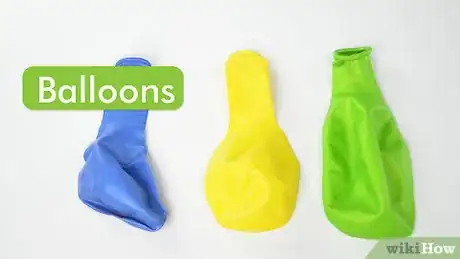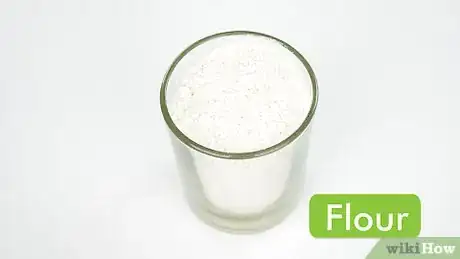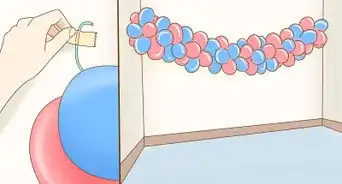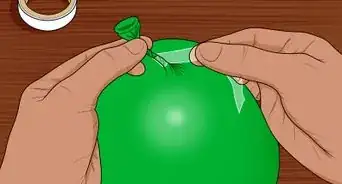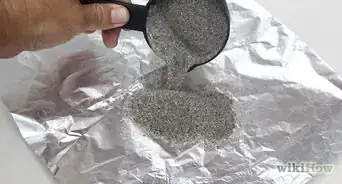This article was medically reviewed by Luba Lee, FNP-BC, MS. Luba Lee, FNP-BC is a Board-Certified Family Nurse Practitioner (FNP) and educator in Tennessee with over a decade of clinical experience. Luba has certifications in Pediatric Advanced Life Support (PALS), Emergency Medicine, Advanced Cardiac Life Support (ACLS), Team Building, and Critical Care Nursing. She received her Master of Science in Nursing (MSN) from the University of Tennessee in 2006.
This article has been viewed 573,930 times.
Stress balls are easy to make from easily available materials. All you need is a few balloons and the right material to put in them. If you want your stress ball to feel more similar to a commercial stress ball, the sewing method may give you the results you're looking for.
Steps
Making a Stress Balloon
-
1Gather an uninflated balloon. Don't use water balloons, which are too thin and weak for this purpose, and will easily burst.[1]
-
2Choose a filling. For a typical palm-sized stress ball, you'll need approximately 160 to 240 grams (5.6 to 8.5 oz) of filling. Any of these will do:
- For a firm stress ball, use flour, baking soda,[2] or cornstarch (a white powder called cornflour in the Commonwealth).
- For a looser stress ball, use dry rice lentils, small beans, or split peas, or fine play sand from a hardware store.
- Mix a small amount of dried rice into flour for something in between. This is also more durable than flour alone.
Advertisement -
3Blow up the balloon slightly (optional). This isn't always necessary but can be useful if the balloon isn't elastic enough to fit the filling. Blow it up to about 3 to 5 inches (7.6 to 12.7 cm) across, then pinch the neck shut without tying it.
- This is easiest to do with a clip or assistant to hold it closed.
- This can make the filling process messier if the air escapes while you're filling it.
-
4Stick a funnel into the neck. If you do not have a funnel, spoon the filling into a plastic bottle instead, and fit the balloon over the neck. A plastic cup pinched to form a spout will work too, but tends to make a mess.[3]
-
5Fill the balloon slowly. For a typical palm-sized ball, you'll want to fill the balloon approximately 2 to 3 inches (5.1 to 7.6 cm) deep. Pour slowly to avoid clogging the neck of the balloon.
- If it clogs, use a pencil or spoon handle to clear the opening.
-
6Pinch out excess air and tie closed. Remove the balloon from the funnel and let out as much air as you can. Tie the neck of the balloon closed tightly.
- To release the air, pinch near the neck and separate your finger and thumb slightly. Too wide an opening can blow flour everywhere.[4]
-
7Snip off the excess rubber. Use a sharp pair of scissors to cut off the dangling end of the balloon. Don't try to cut too close to the knot, or it could come undone.
Sewing a Stress Ball
-
1Wrap a small rubber ball in memory foam. You can find the rubber ball from children's toy stores, and memory foam at some fabric stores or specialized online stores.[5] You'll want a piece of memory foam roughly 3.5 x 5 inches (9 x 12.5 cm) in size, and anywhere from 1 to 3 inches (2.5–7.5 cm) thick. A thicker piece of memory foam will make a softer, more squeezable stress ball.
-
2Sew the foam around the rubber ball. Wrap the foam around the rubber ball and sew the memory foam together with needle and thread to enclose the ball completely. Snip off excess memory foam if necessary to make a rough spherical shape.
-
3Finish by sewing a sock or piece of thick fabric around the memory foam. An old sock will provide a durable outer covering, but you can use a thick piece of fabric instead. Snip the sock or fabric to make it a tight sphere around the memory foam. Your squeeze ball is now complete.
Things you'll need
Balloon method:
- One balloon (not a water balloon)
- 160 to 240 grams (5.6 to 8.5 oz) flour, baking soda, cornstarch, fine play sand, dried rice, lentils, beans, or split peas
- Funnel or plastic bottle
Sewing method:
- Needle and thread
- Sock
- Memory foam
- Small rubber ball
Warnings
- Fillings with water or salt can weaken the balloon rubber and wear out the stress ball more quickly.⧼thumbs_response⧽
- Wrapping multiple balloons around your stress balloon will add more friction, making it more likely to break.⧼thumbs_response⧽
References
- ↑ https://www.youtube.com/watch?v=Fz5iEBdJM84/
- ↑ https://www.weareteachers.com/stress-balls/
- ↑ https://patch.com/us/dealtown/buy-or-diy-how-make-squishy-stress-ball
- ↑ https://www.oola.com/life-at-home/2454431/how-to-make-an-extra-squishy-diy-stress-ball/
- ↑ https://www.youtube.com/watch?v=_KvQ_KAW7C8
About This Article
To make a stress ball, slip a funnel into the neck of a sturdy balloon. If you want to make a firm stress ball, pour flour, baking soda, or cornstarch into the balloon. If you want your stress ball to be softer, use lentils, split peas, or fine play sand. You can also mix a little rice into your filling if you like. Slowly pour your filling into the funnel, and use a pencil to clear the funnel if it gets clogged. Pinch out any excess air and tie the balloon closed, then snip off any excess rubber from the end of the balloon. To learn more from our Medical Expert co-author, like how to sew a stress ball together, keep reading the article!
